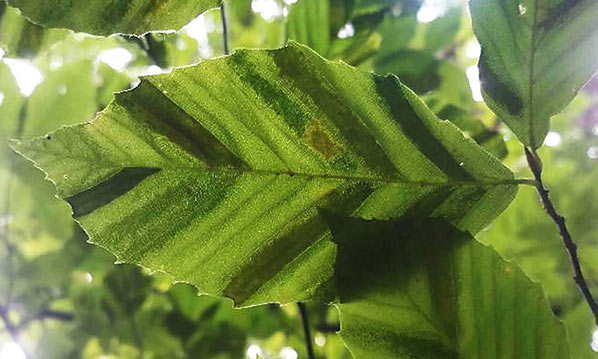Common Insects Affecting Trees in Connecticut
Connecticut’s enchanting landscape is where majestic trees reign supreme, casting their leafy spells of beauty and shade. Yet, these arboreal wonders are not exempt from nature’s mischievous creatures, especially insect invaders. This article uncovers the insects that plague Connecticut’s trees and discusses opportune moments when summoning an arborist can be crucial.

Common Insects Buzzing ‘Round Connecticut’s Trees:
- Beech Leaf Disease (nematodes): This roundworm is especially menacing because it is invisible to the eye and lives within the leaves of your most precious beech trees. It is new to Connecticut and making itself known especially this year. The first sign that your tree may be affected by beech leaf disease is a yellow banding on the leaves. From there, leaves turn brown and shrivel, resulting in leaf drop. This affliction is especially concerning. If you see these symptoms, call your favorite local arborist today!
- Spongy Moth, formerly known as the gypsy moth (Lymantria dispar): These leaf-munching villains are notorious for defoliating trees, leaving them weakened and bereft of their green finery. If your trees suffer from a gypsy moth invasion and resemble a leafless stage, it’s time to call upon the expertise of an arborist to restore the natural order.
- Eastern Tent Caterpillar (Malacosoma americanum): With their silky tents nestled in tree branches, these mischievous caterpillars are ardent leaf nibblers. While most trees can recover from their leafy appetites, an arborist may need to enter the scene if the tent city grows too expansive for your tree’s liking.
- Emerald Ash Borer (Agrilus planipennis): Beware, for an emerald-clad menace lurks amidst ash trees, causing mayhem and tree demise. If you notice your ash tree suffering from a thinning crown, discoloration of the trunk, or peculiar D-shaped exit holes, you may want to seek an arborist’s opinion about your tree’s health.
- Hemlock Woolly Adelgid (Adelges tsugae): These tiny woolly critters have a sweet tooth for hemlock trees, painting the branches with their snowy, woolly masses. When your hemlock shows signs of a woolly infestation, marked by yellowed needles and a sorrowful decline, it’s time to beckon an arborist to save the day.
When to Call a Licensed Arborist:
Amidst the natural dance between trees and insects, there are critical moments when an arborist’s input is necessary:
- Puzzling Pest Identification: When an insect invasion perplexes you, leaving you scratching your head, an arborist’s wisdom and a keen eye can unveil the mystery and prescribe the perfect solution.
- Insect Infestation: When the pests throw a grand party, infesting your trees on a massive scale, it’s a clear sign that an arborist must step onto the scene with their arsenal of bug-banishing spells and potions.
- Vigilant Guardianship and Advice: Embrace the role of a tree guardian by inviting an arborist for regular inspections. With their watchful eye and mystical foresight, they can detect pests’ early signs and guide you on how to thwart them, and help you to determine how to move forward in order to keep your trees and property safe and healthy.
In Connecticut’s whimsical realm of trees and buzzing critters, it’s essential to safeguard these arboreal treasures. By familiarizing yourself with common pests and recognizing when to call an arborist, you’re on your way to doing your part to protect your trees. Not sure where to start, give Arbortech Tree a call or reach out for a free tree estimate today.

